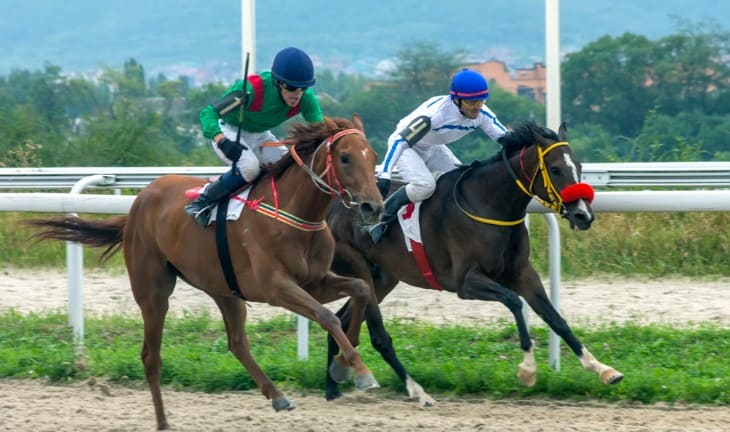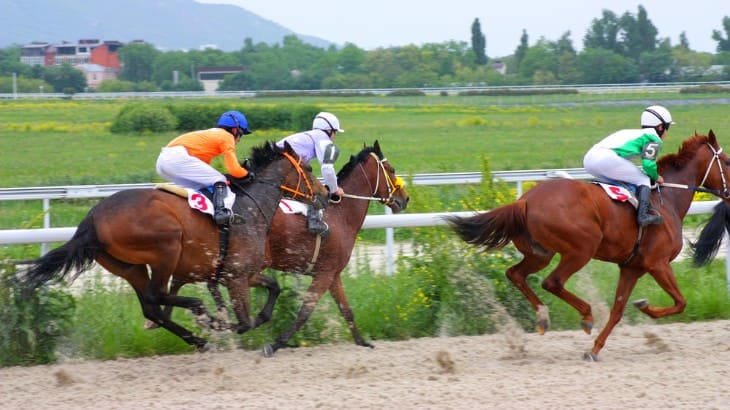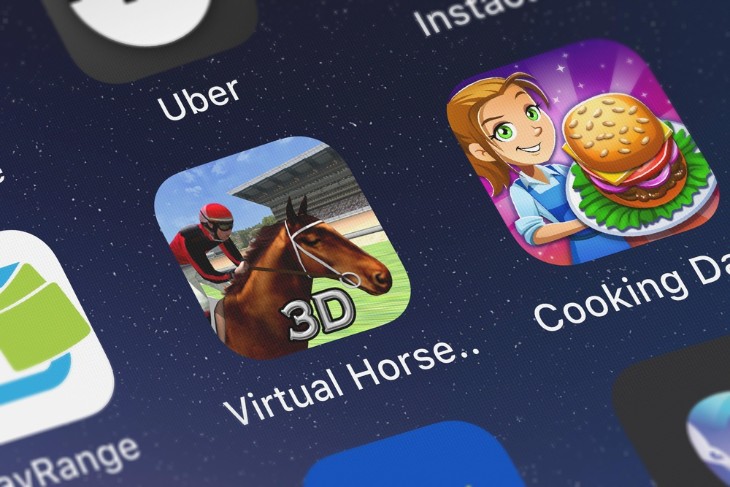Virtual reality (VR) technology has not been extensively used in horse racing so far, but there were some conceptual discussions and limited applications in the industry. However, things might evolve pretty soon and this article is all about how virtual reality could potentially be used in horse racing.
Training and Simulation
Training and simulation using virtual reality (VR) in the context of horse racing involves creating realistic and immersive environments to help trainers, jockeys, and even horses improve their skills and performance. Here's a deeper look into how VR can be utilized for training and simulation in the horse racing industry:
- Realistic Race Scenarios: VR technology can recreate racecourses, tracks, and environments in a highly accurate manner. Trainers and jockeys can then use VR headsets to virtually experience the racecourse, simulating race conditions, terrains, and challenges they might encounter during actual races.
- Jockey Training: Jockeys can use VR simulations to practice riding techniques, positioning, and decision-making during races. They can experience different scenarios, such as dealing with a crowded field, navigating turns, and adjusting their riding strategy based on the behaviour of other horses.
- Horse Conditioning: Horses can also benefit from VR simulations. A horse can be familiarized with the racecourse layout and sounds, reducing potential anxiety or stress on race day. This can be particularly useful for young or inexperienced horses.
- Risk-Free Practice: VR simulations provide a safe environment for both jockeys and horses to practice without the inherent risks of actual racing. Jockeys can experiment with different strategies, and horses can become accustomed to race environments before competing.
- Analyzing Performance: VR simulations can generate data on jockey performance and horse behaviour. This data can then be analyzed to identify areas for improvement, such as refining riding techniques, optimizing pacing, and enhancing communication between jockey and horse.
- Adapting to Different Conditions: VR can simulate various weather conditions and track surfaces. This allows jockeys and horses to practice adapting to changing conditions, whether it's racing on a wet track or a dry one, thus enhancing their versatility.
- Mental Preparation: Beyond the physical aspect, VR can also help jockeys mentally prepare for races. They can experience the excitement, pressure, and adrenaline of a race environment, helping them manage stress and anxiety.
- Remote Training: Trainers and jockeys can access VR training sessions remotely, which is especially valuable for international trainers who might not have direct access to certain racecourses. This widens the scope of training opportunities.
- Injury Rehabilitation: Injured jockeys could use VR simulations to maintain their skills and stay engaged with racing while they recover. It can also be used for physical therapy exercises in a controlled environment.
- Customization and Feedback: VR simulations can be customized to focus on specific areas of improvement. Additionally, the technology can provide instant feedback to both jockeys and trainers, helping them understand their performance and make adjustments quickly.
Fan Engagement
Virtual Reality (VR) also has the potential to revolutionize fan engagement in the world of horse racing by offering a highly immersive and interactive experience. Let’s take a closer look at how VR can enhance fan engagement in the horse racing industry:
- Virtual Race Attendance: VR allows fans to virtually attend horse races from the comfort of their homes. They can put on VR headsets and feel as though they're right at the racecourse, experiencing the excitement, sights, and sounds of the event in a 360-degree immersive environment.
- Multiple Viewing Angles: Fans can switch between different camera angles in real time, offering perspectives from various locations around the racecourse. This enables them to get a better view of the action, just as if they were physically present.
- Jockey's Perspective: VR can provide fans with the unique opportunity to experience a horse race from the perspective of a jockey. This perspective can offer an unparalleled sense of speed and intensity, giving fans a deeper understanding of what it's like to be in the saddle.
- Interactive Betting: Virtual reality can create a realistic betting environment where fans can place virtual bets on virtual horse races. This adds an interactive and immersive layer to the betting experience, making it more engaging and exciting.
- Historical Races and Moments: VR can recreate iconic historical horse races and moments, allowing fans to relive legendary performances. This can be particularly appealing to long-time fans and history enthusiasts.
- Behind-the-Scenes Access: VR experiences can take fans behind the scenes, showcasing aspects of horse racing that are usually hidden from view. This might include visits to the stables, conversations with jockeys and trainers, and insights into the preparation and care of horses.
- Interactive Learning: VR can be used as an educational tool to teach fans about the mechanics of horse racing. It can offer interactive tutorials on race strategies, horse anatomy, and other relevant topics.
- Social Interaction: Fans can virtually connect with other fans who are also attending the VR experience. This creates a social element similar to attending a live event, enabling fans to discuss the races and share their excitement.
- Access to Global Races: Fans from around the world can experience races from different countries and tracks without the need for travel. This can help promote horse racing as a global sport.
- Promotion and Marketing: VR experiences can be used for promotional purposes, giving potential attendees a taste of what it's like to attend a live horse race. This could attract more people to the sport and increase event attendance.
- Enhanced Engagement during Off-Season: VR experiences can keep fans engaged even during the off-season or during times when there are no live events taking place.
Interactive Learning
Interactive learning through the use of virtual reality (VR) in the context of horse racing can provide educational experiences that are engaging, immersive, and informative. Let’s take a more detailed look:

- Anatomy and Physiology: VR can offer detailed, three-dimensional visualizations of horse anatomy and physiology. Learners can explore different systems, such as the musculoskeletal, circulatory, and respiratory systems, gaining a better understanding of how a horse's body functions.
- Race Strategy and Tactics: Virtual reality simulations can teach learners about race strategies and tactics. Users can virtually experience races from different perspectives (jockey, spectator, trainer) and learn about the decision-making process during a race.
- Jockey Training: Aspiring jockeys can use VR to simulate riding experiences. They can practice techniques like steering, pacing, and manoeuvring within a realistic virtual environment, aiding in their training and development.
- Track Familiarization: VR can recreate various racetracks, enabling jockeys, trainers, and even fans to become familiar with track layouts, curves, slopes, and other unique features. This familiarity can contribute to better race preparation.
- Stable Management: Virtual reality can offer interactive lessons on stable management, horse care, grooming, and feeding routines. Learners can virtually participate in these activities to understand the daily tasks involved in maintaining horses.
- Injury Prevention and Care: VR scenarios can depict scenarios related to horse health and injuries. Learners can virtually diagnose common equine health issues, learn proper care techniques, and explore injury prevention strategies.
- Interactive Quizzes and Challenges: VR can incorporate interactive quizzes and challenges within the learning experience. This gamification element can enhance engagement and help reinforce the knowledge being presented.
- Racecourse Exploration: Learners can virtually explore different racecourses from around the world. This can help them understand the diversity of tracks and how they influence race outcomes.
- Real-time Data Visualization: VR can visualize real-time race data in an interactive and dynamic way. This can include data on jockey performance, horse speeds, and race standings, providing a deeper understanding of race dynamics.
- Historical Insights: VR can take learners back in time to experience historical races and moments in horse racing. This can provide a context-rich learning experience and help learners appreciate the evolution of the sport.
- Virtual Workshops and Seminars: Trainers, experts, and jockeys can conduct virtual workshops and seminars using VR technology. Learners can participate remotely and interact with the instructors, asking questions and receiving real-time feedback.
- Problem-Solving Scenarios: VR scenarios can present learners with complex scenarios, such as unexpected race events or horse-related challenges. Learners can make decisions and experience the consequences, enhancing their critical thinking skills.
Virtual Betting
Virtual betting is a concept that merges virtual reality (VR) technology with the betting experience, allowing users to place bets on simulated events that take place within a virtual environment. In the context of horse racing, virtual betting can offer a unique and engaging way for people to experience the excitement of wagering without the need for real horses and races.
- Simulated Races: Virtual betting platforms create realistic virtual horse races using computer-generated graphics and algorithms. These races simulate the behaviour and performance of horses based on various factors like speed, form, and track conditions.
- Betting Markets: Just like traditional betting, virtual betting offers a range of betting markets. Users can place bets on virtual horses to win, place, or show, and they can also engage in exotic bets like exactas, trifectas, and more.
- Realistic Odds: Virtual betting systems use complex algorithms to generate odds for each horse based on its simulated performance characteristics. These odds reflect the horse's perceived chances of winning the virtual race.
- Immersive Experience: Virtual reality can enhance the immersive aspect of virtual betting. Users can put on VR headsets to watch the virtual races from different angles, making them feel like they're present at the racecourse.
- Instant Gratification: Virtual races typically have shorter durations compared to real races. This means that users can experience the outcome of their bets more quickly, leading to a faster-paced betting experience.
- Continuous Availability: Virtual betting can be available around the clock, regardless of whether real horse races are taking place. This provides a constant betting opportunity for users.
- Risk-Free Entertainment: Virtual betting offers a risk-free environment for users to enjoy the thrill of betting. Since the outcomes are based on simulations, users are not risking real money, making it suitable for entertainment purposes.
- Varied Track Conditions: Virtual races can be set on various track conditions, including turf, dirt, and different weather scenarios. This adds diversity to the betting experience.
- Educational Value: Virtual betting platforms can provide insights into handicapping and betting strategies. Users can learn about how odds are calculated and develop their betting skills.
- Community and Competition: Virtual betting platforms can create a sense of community among users. Players can compete against each other in leaderboards, discuss strategies, and share their experiences.
- Accessible to All: Virtual betting can be accessible to a wide range of people, including those who might not have easy access to real horse racing events or betting locations.
Scouting and Course Analysis
Scouting and course analysis using virtual reality (VR) involves using immersive technology to explore, analyze, and prepare for different racecourses. This can benefit trainers, jockeys, and even spectators by providing a detailed understanding of the track layout, terrain, and conditions.
- Virtual Track Exploration: With VR, trainers and jockeys can virtually explore various racecourses from around the world. They can examine the track layout, turns, straightaways, and other features in a highly detailed and immersive 3D environment.
- Terrain and Surface Analysis: VR simulations can replicate different track surfaces such as turf, dirt, and synthetic materials. This allows jockeys and trainers to analyze how their horses might perform on each surface and adjust their strategies accordingly.
- Visualizing Track Conditions: VR can simulate different weather conditions, including rain, sunshine, and varying light levels. This helps users anticipate how changing weather might impact the track and race dynamics.
- Practice Runs: Jockeys can virtually "ride" the track using VR simulations. They can practice navigating turns, pacing, and adjusting their riding techniques to suit the specific features of the track.
- Strategy Development: Trainers and jockeys can use VR to develop race strategies based on the track's characteristics. For instance, they can plan when to accelerate, when to hold back, and where to position the horse during different stages of the race.
- Risk Assessment: By virtually experiencing the track, jockeys can identify potential challenges and risks associated with specific portions of the course. This allows them to make informed decisions to ensure both horse and rider safety.
- Data Integration: VR simulations can incorporate real race data, allowing users to analyze previous races held on the same track. This data-driven analysis can provide insights into successful strategies and outcomes.
- International Racecourses: For jockeys and trainers who compete on an international level, VR can provide a way to become familiar with foreign racecourses without physically travelling to them.
- Track Familiarization: For inexperienced horses, exposure to the virtual track can help reduce anxiety and stress on race day. This is particularly valuable for young or new horses.
- Remote Preparation: Trainers and jockeys can analyze and prepare for upcoming races from any location, thanks to the accessibility of VR technology. This is especially useful when they can't physically visit the racecourse in advance.
- Visualizing Challenges: VR can simulate specific challenging sections of a track, allowing trainers and jockeys to work on strategies to navigate those sections more effectively.
- Course Variations: Some tracks have different configurations or layouts for different race lengths. VR can simulate these variations, helping jockeys and trainers anticipate how the course might change for their specific race.

Rehabilitation and Conditioning
Virtual reality can play a role in rehabilitation and conditioning programs for both jockeys and horses in the horse racing industry. It offers a controlled and customizable environment for training, therapy, and recovery. Here's a closer look:
- Injury Rehabilitation: Jockeys who sustain injuries can use VR to simulate riding experiences in a controlled environment before returning to actual racing. This helps them regain confidence and muscle memory while minimizing the risk of re-injury.
- Physical Therapy: VR can facilitate physical therapy exercises tailored to a jockey's specific needs. Motion tracking and interactive simulations can guide them through targeted exercises to improve strength, flexibility, and coordination.
- Balance and Coordination Training: Jockeys rely on precise balance and coordination during races. VR can provide balance training exercises that mimic the movements and challenges they face during a race.
- Mental Conditioning: Recovering from an injury can be mentally challenging. VR can simulate race scenarios, allowing jockeys to mentally rehearse their strategies and decisions before returning to the track.
Promotion and Marketing
Promotion and marketing in the horse racing industry can benefit from the use of virtual reality technology. VR can offer a unique and immersive way to engage potential attendees, sponsors, and fans, creating memorable experiences that can help generate interest and excitement.
- Virtual Race Previews: VR can provide potential attendees with virtual previews of upcoming races. This allows them to experience the atmosphere of the racecourse, observe the track conditions, and get a sense of what the event will be like before making a decision to attend.
- Venue Tours: Virtual reality can offer detailed tours of the racecourse facilities, including the grandstands, hospitality areas, and stables. This gives potential attendees a comprehensive view of the entire event venue.
- Sponsorship Activation: Sponsors can use VR to create interactive experiences that showcase their products or services. For example, a horse feed company could create a VR experience showing how their feed contributes to a horse's performance and well-being.
- Interactive Betting Demonstrations: Horse racing organizations can use VR to offer interactive demonstrations of how betting works. This can help newcomers understand the betting process and encourage them to engage in wagering.
- Behind-the-Scenes Content: VR can take fans behind the scenes, providing them with exclusive access to areas like the paddock, stables, and jockey locker rooms. This adds a sense of exclusivity and intrigue.
- Fan Engagement Activities: Virtual reality experiences can be used as part of fan engagement activities. For instance, fans could participate in virtual reality challenges or games related to horse racing, both on-site and online.
- Virtual Fan Events: Virtual reality can enable the creation of online fan events where attendees can virtually interact with trainers, jockeys, and other fans. This can include Q&A sessions, autograph signings, and more.
- Promotional Content: Promotional materials such as videos and advertisements can be created in a VR format, offering a more immersive and engaging way to showcase upcoming events and highlights.
- Global Accessibility: VR experiences can be accessed by people from around the world, potentially expanding the reach of horse racing events to a global audience.
- Interactive Marketing Campaigns: Marketers can design interactive VR campaigns that encourage users to engage with the content and share their experiences on social media platforms. This can help create a buzz around the event.
- Data-Driven Insights: Virtual reality platforms can gather data on user interactions and preferences, providing valuable insights into what engages the audience most.
- VIP and Hospitality Experiences: Horse racing venues can offer virtual previews of VIP and hospitality packages, giving potential attendees a taste of the premium experiences available.
Data Visualization
Data visualization using virtual reality (VR) involves presenting complex data sets and information in a three-dimensional, immersive environment. In the context of horse racing, VR data visualization can provide trainers, jockeys, analysts, and even fans with a more intuitive and interactive way to understand race data, statistics, and insights.
- Race Analytics in 3D: VR can represent race data, such as horse speeds, jockey positions, and race standings, as dynamic 3D visualizations. This helps users grasp the spatial relationships between elements and gain a deeper understanding of race dynamics.
- Interactive Dashboards: VR can offer interactive dashboards that allow users to explore data by manipulating virtual objects or selecting specific data points. This hands-on approach enhances engagement and enables personalized data exploration.
- Performance Tracking: Trainers and jockeys can visualize historical performance data for horses and riders. This can aid in identifying patterns, strengths, and areas for improvement over time.
- Track Analysis: VR data visualization can overlay historical race data onto a virtual representation of a racecourse. This provides insights into how different parts of the track affect race outcomes.
- Race Replay and Analysis: VR can recreate race scenarios, allowing users to virtually "replay" past races from different angles and perspectives. This enables more in-depth analysis of specific moments during the race.
- Real-time Insights: During live races, VR data visualizations can display real-time race data, giving analysts and fans a dynamic view of how the race is unfolding.
- Weather and Track Conditions: Users can visualize the impact of changing weather and track conditions on race performance through interactive VR simulations.
- Trends and Patterns: VR data visualization can highlight trends, patterns, and correlations in horse racing data that might not be as easily apparent through traditional charts and graphs.
- Bet Analysis: For those interested in betting, VR data visualization can present historical betting trends and outcomes to inform betting decisions.
- Training Insights: Trainers can visualize training data, such as heart rate, speed, and distance covered, in VR. This helps them fine-tune training regimens for horses.
- Rider Analysis: For jockeys, VR can visualize riding data, including riding posture, speed adjustments, and decision-making patterns.
- Engaging Learning Tool: VR data visualization can be used as an educational tool to help newcomers understand race data and horse racing statistics in a more engaging and interactive manner.
Summary
Virtual reality has the potential to transform various aspects of the horse racing industry. For training and simulation, VR offers a safe environment for jockeys to practice and refine their skills while enabling trainers to simulate race scenarios and horse behaviour. VR enhances fan engagement by allowing virtual attendance, multiple viewing angles, and interactive learning experiences, attracting a global audience.
It aids in scouting and course analysis by virtually exploring tracks, analyzing terrain, and preparing jockeys for race conditions. Additionally, VR supports rehabilitation and conditioning for injured jockeys and horses through tailored exercises and mental preparation. Lastly, VR contributes to promotion and marketing by offering virtual previews, sponsor activations, and immersive behind-the-scenes experiences, fostering excitement and engagement within the horse racing community.
For more information:







